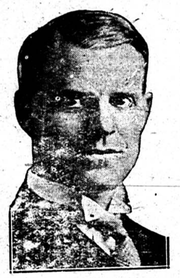Joseph Tweed Shaw
| Joseph Tweed Shaw | |
|---|---|
 | |
| Member of the Canadian House of Commons | |
|
In office 1921–1925 | |
| Preceded by | Thomas Tweedie |
| Succeeded by | Richard Bennett |
| Constituency | Calgary West |
| Member of the Legislative Assembly of Alberta | |
|
In office June 28, 1926 – June 19, 1930 | |
| Preceded by | Charles Mitchell |
| Succeeded by | John Mackintosh |
| Constituency | Bow Valley |
| Leader of the Alberta Liberal Party | |
|
In office 1926–1930 | |
| Preceded by | John Bowen |
| Succeeded by | John McDonald |
| Personal details | |
| Born |
August 30, 1883 Port Arthur, Ontario |
| Died |
July 12, 1944 (aged 60) Calgary, Alberta[1] |
| Political party |
Independent Labour, Liberal |
| Occupation | politician |
Joseph Tweed Shaw (August 30, 1883 – July 12, 1944) was a Canadian politician. He served in the Canadian House of Commons from 1921 to 1925 as an independent Labour Member of Parliament (MP), and later became leader of the Alberta Liberal Party.
Early life
Shaw was born at Port Arthur in Northern Ontario, and received his early education in Calgary, Alberta. He later received a Bachelor of Laws degree from the University of Michigan, and returned to Alberta to work as a barrister. He served in the Canadian Expeditionary Force during World War I from 1916 to 1918. In religion, he was a Presbyterian.
Political career
He was elected to the Canadian House of Commons in the 1921 federal election, defeating future Conservative Prime Minister Richard Bennett by twelve votes in Calgary West. Shaw is usually considered to have been a Labour candidate but he actually ran as an independent, supported by both the United Farmers of Alberta (UFA) and the Alberta branch of the Dominion Labor Party (DLP). He attended a Progressive Party convention in 1922 and may have been a candidate for that party's leadership, but he reaffirmed his independence from all parties in 1923. During his time in parliament, Shaw was associated with the Ginger Group of radical Labour and Progressive representatives.
Shaw sought re-election in 1925 as an independent candidate, and this time received unofficial support from the Liberal Party of Canada. He lost to Bennett in a rematch of 1921, and subsequently became affiliated with the Alberta Liberal Party. On April 21, 1926, he was chosen without opposition as leader of the provincial party. From his new position, he attacked Alberta's UFA ministry as the government of a class rather than of all the people. A provincial election was called for June, and Shaw led his party to a disappointing 7 seats of out 61. He was personally elected in Bow Valley by a single vote, and served as an opposition member for the next four years.
Shaw never served as Leader of the Opposition in the legislature, after a Speaker's ruling that divided the Official Opposition funding between all the party leaders. He did not seek re-election in 1930. He attempted a return to the House of Commons in the 1935 federal election, but was defeated in Calgary East. He also campaigned for the "Independent Movement" (a fusion of Liberals and Progressive Conservatives) in the 1940 provincial election, but again failed to win a seat. He died four years later.
References
- ^ Anthony Mardiros, William Irvine: The Life of a Prairie Radical, (Toronto: J. Lorimer, 1979), p. 112. The Canadian parliamentary website lists him as a Labour MP, but this is an error.
- ^ William L. Morton, The Progressive Party in Canada, (Toronto: University of Toronto Press, 1950), p. 182.
- ^ Mardiros, p. 173.
- ^ Mardiros, p. 168.